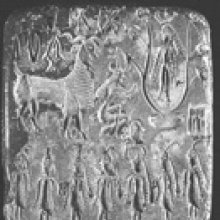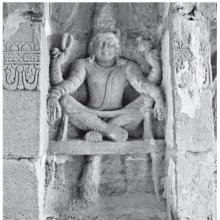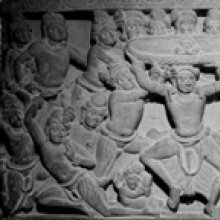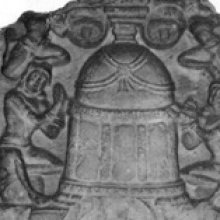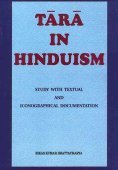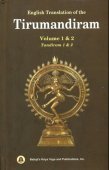Worship: 3 definitions
Introduction:
Worship means something in Hinduism, Sanskrit. If you want to know the exact meaning, history, etymology or English translation of this term then check out the descriptions on this page. Add your comment or reference to a book if you want to contribute to this summary article.
Images (photo gallery)
(+142 more images available)
In Hinduism
Shaktism (Shakta philosophy)
Source: Google Books: ManthanabhairavatantramWorship (most commonly called pūjā, pūjana or arcana) in Tantra represents the worship of images or other representations—stones, liṅgas, trees and the like, in which deities or supernatural beings reside. The basic Tantric rites are centred on the worship of the main deity, single or paired with a consort in a maṇḍala. The maṇḍala summates and makes directly and conveniently accessible to worship parts, more or less extensive of the pantheon. A fully developed Tantric system has one major maṇḍala which is uniquely specific to it in which the main deity is worshipped. Invariably, other maṇḍalas are described and worshipped. These may be very many, but they serve to worship secondary deities or aspects of the main one for specific purposes, that may be more or less extensive.

Shakta (शाक्त, śākta) or Shaktism (śāktism) represents a tradition of Hinduism where the Goddess (Devi) is revered and worshipped. Shakta literature includes a range of scriptures, including various Agamas and Tantras, although its roots may be traced back to the Vedas.
Vastushastra (architecture)
Source: Shodhganga: Elements of Art and Architecture in the Trtiyakhanda of the Visnudharmottarapurana (vastu)The Worship (of God) is denoted by the Sanskrit term Devatāpūjana, and is highly recommended to attain the supreme happiness, according to the Viṣṇudharmottarapurāṇa, an ancient Sanskrit text which (being encyclopedic in nature) deals with a variety of cultural topics such as arts, architecture, music, grammar and astronomy.—The Viṣṇudharmottarapurāṇa suggests two ways of worship in this context-one is antarvedi and another is bahirvedi. The sacrifices undertaken for worshiping a deity were associated with the procedure called antarvedi and other procedures like upavāsa, vrata etc. were recognized as the procedure of bahirvedi type of worship. Both these procedures of worship are seen to be practised in Hinduism. These procedures may be at the bottom of the idea of temple building.

Vastushastra (वास्तुशास्त्र, vāstuśāstra) refers to the ancient Indian science (shastra) of architecture (vastu), dealing with topics such architecture, sculpture, town-building, fort building and various other constructions. Vastu also deals with the philosophy of the architectural relation with the cosmic universe.
General definition (in Hinduism)
Source: Shodhganga: Impact of Vedic culture on society as reflected in select Sanskrit inscriptions (h)Worship of the gods and goddesses forms an important ritual in Brahmanical fold. The gods belong to different groups and are supposed to live in different worlds, but they all belong to one large family. The Vedas contain numerous references to deities. Due to such diversity in beliefs and practices Brahmanism has a distinctive place in the history in the world. Traditions like Shaivism and Vaishnavism evolved over time within Brahmanism and added colours and vibrations to it. The most popular gods in the Vedic pantheon are Indra and Agni. The highest number of hymns in the four Vedas has been dedicated to them. People mainly worshipped the Vedic deities and they performed sacrifices to propitiate the gods and made offerings to them. In later times the principal Vedic gods lost their stronghold to Puranic gods in popular faith. [...]
See also (Relevant definitions)
Starts with: Worship of serpents, Worshipper, Worshipping.
Query error!
Full-text (+13299): Puja, Arcana, Upasana, Gurupuja, Vandana, Naivedya, Mudra, Arca, Pujana, Dhupa, Pushpa, Bhakti, Padma, Karavira, Pujaka, Dipa, Jaya, Linga, Aradhana, Yantra.
Relevant text
Search found 482 books and stories containing Worship, The worship, Worships; (plurals include: Worships, The worships, Worshipses). You can also click to the full overview containing English textual excerpts. Below are direct links for the most relevant articles:
Shiva Purana (by J. L. Shastri)
Chapter 26 - The worship of Śiva with the ancillary rites < [Section 7.2 - Vāyavīya-saṃhitā (2)]
Chapter 19 - The worship of Śiva’s Earthen phallic image (pārthiva-liṅga) < [Section 1 - Vidyeśvara-saṃhitā]
Chapter 14 - Directions for the worship of Śiva < [Section 2.1 - Rudra-saṃhitā (1): Sṛṣṭi-khaṇḍa]
Shaivacintamani (analytical study) (by Swati Sucharita Pattanaik)
Part 8 - Benefits of worship < [Chapter 3: Śaiva tradition and Śaivacintāmaṇi]
Part 7 - Offerings and Worship < [Chapter 3: Śaiva tradition and Śaivacintāmaṇi]
Part 15 - Benefits of Śiva worship < [Chapter 3: Śaiva tradition and Śaivacintāmaṇi]
Mahabhagavata Purana (translation and study) (by Prabir Kumar Nanda Goswami)
Chapter 81 - The dialogue between Narada and Mahadeva (conclusion)
Chapter 6 - Socio-religious condition during the period < [Study]
Skanda Purana (by G. V. Tagare)
Chapter 203 - Greatness of Maṅkīśvara (Maṅkī-īśvara) < [Section 1 - Prabhāsa-kṣetra-māhātmya]
Chapter 33 - Rules pertaining to Prabodhinī < [Section 4 - Kārttikamāsa-māhātmya]
Chapter 8 - The Greatness of Tulasī < [Section 5 - Mārgaśīrṣa-māhātmya]
Ishavasya Upanishad with Shankara Bhashya (Sitarama) (by S. Sitarama Sastri)
Bhagavad-gita (with Vaishnava commentaries) (by Narayana Gosvami)
Verse 9.23 < [Chapter 9 - Rāja-guhya-yoga (Yoga through the most Confidential Knowledge)]
Verse 9.34 < [Chapter 9 - Rāja-guhya-yoga (Yoga through the most Confidential Knowledge)]
Verse 9.25 < [Chapter 9 - Rāja-guhya-yoga (Yoga through the most Confidential Knowledge)]
Related products
(+7 more products available)
